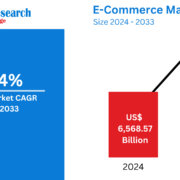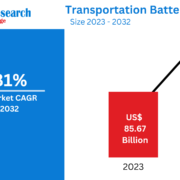E-Commerce Market Insights 2025-2033| Growth & Opportunity Analysis
Press Release: Global E-Commerce Market Size, Share, Trends, and Forecast 2025–2033
Global E-Commerce Market Set to Surpass US$ 12.6 Trillion by 2033, Driven by Cross-Border Trade, AI Integration, and Digital Payment Innovations
The global e-commerce market is poised for substantial growth, projected to rise from USD 6,568.57 billion in 2024 to USD 12,632.68 billion by 2033, expanding at a CAGR of 7.54% during the forecast period. This surge is underpinned by the increasing adoption of artificial intelligence (AI), robust cross-border trade capabilities, and advances in digital payment security and systems.
Market Overview: A Digital Revolution in Retail
The global e-commerce industry has undergone a transformative evolution over the past decade, fundamentally reshaping the retail landscape. The traditional brick-and-mortar model is increasingly being supplemented or replaced by digital storefronts, offering consumers unmatched convenience, broader product access, and real-time purchasing capabilities.
The sector’s acceleration was further catalyzed by the COVID-19 pandemic, which pushed consumers toward online platforms for everyday essentials, luxury goods, and professional services. Increased internet penetration, widespread smartphone usage, and the rising comfort with digital financial tools have further strengthened this momentum.
As e-commerce matures, new trends such as AI-powered personalization, virtual try-on tools, and social commerce are redefining consumer expectations and competitive dynamics.
Key Market Drivers
1. Cross-Border E-Commerce Surge
Globalization and digitalization have reduced the barriers to international trade, allowing consumers to access products from around the world. Improvements in global logistics networks, fulfillment centers, and third-party logistics have significantly streamlined international delivery operations. This has led to increased product variety, competitive pricing, and a broader customer base for e-commerce retailers.
2. AI-Powered Customer Experiences
Artificial intelligence is playing a pivotal role in transforming e-commerce platforms. From predictive analytics and personalized recommendations to automated customer service chatbots and virtual fitting rooms, AI is driving user engagement and reducing return rates. Zalando’s 3D avatar virtual fitting room is a prime example of how AI enhances shopping satisfaction.
3. Evolution of Secure Digital Payments
The growing adoption of digital wallets, contactless cards, and Buy Now, Pay Later (BNPL) solutions is simplifying checkout experiences and boosting transaction volumes. Enhanced encryption technologies and multi-factor authentication have bolstered consumer confidence, driving digital wallet usage and facilitating seamless global payments.
Market Challenges
1. Cybersecurity and Data Privacy
With growing volumes of sensitive data being shared online, cybersecurity is a paramount concern. Data breaches and cyberattacks can lead to significant reputational and financial damage. Regulatory frameworks such as GDPR and CCPA mandate stricter compliance, necessitating continuous investment in encryption, authentication, and secure platforms.
2. Return and Refund Complexities
E-commerce companies face significant logistical and financial burdens related to returns, especially in fashion and electronics. Efficient return management systems, transparent policies, and reverse logistics innovations are crucial to mitigate costs and maintain consumer trust.
Regional Insights
United States
The U.S. e-commerce market is one of the most mature globally, dominated by players like Amazon, Walmart, and eBay. Innovations in mobile commerce, same-day delivery, and voice-assisted shopping are shaping consumer behavior. Cybersecurity and return logistics remain top concerns.
Germany
Germany’s e-commerce space is robust, supported by high internet penetration and trusted payment solutions. Zalando and Amazon.de are dominant platforms. Mobile shopping is gaining traction, but challenges include strict data privacy laws and logistical efficiency.
India
India’s e-commerce boom is driven by mobile internet access, digital payment apps, and a young, tech-savvy population. While platforms like Amazon India and Flipkart lead, regional players are emerging fast. However, logistics and price sensitivity continue to be key hurdles.
United Arab Emirates
The UAE’s market benefits from a high digital adoption rate, affluent population, and efficient delivery networks. Amazon.ae and Noon are top players. Mobile and social commerce are rapidly growing segments. Government-led digital innovation initiatives are expected to further boost market expansion.
Market Segmentation
By Product Categories
- Food and Beverage
- Apparel and Accessories
- Health, Personal Care & Beauty
- Computer & Consumer Electronics
- Office Equipment & Supplies
- Toys and Hobby
- Furniture and Home Furnishing
- Books/Music/Video
- Others
By Payment Method
- Digital Wallet
- Credit Card
- Debit Card
- Account-to-Account (A2A)
- Buy Now, Pay Later (BNPL)
- Cash on Delivery
- Prepay
- Others (Including Cryptocurrency)
Regional Coverage
- North America: U.S., Canada
- Europe: Germany, France, UK, Italy, Spain, etc.
- Asia Pacific: China, India, Japan, Australia, etc.
- Latin America: Brazil, Mexico, Argentina
- Middle East & Africa: UAE, Saudi Arabia, South Africa
Competitive Landscape
Major players are focusing on market expansion, AI integration, and customer experience to maintain competitive advantages. Mergers, acquisitions, and strategic collaborations are on the rise.
Key Companies Profiled
- Amazon.com Inc.
- Alibaba Group Holding Limited
- eBay Inc.
- Rakuten Inc.
- Walmart Inc.
- Zalando SE
- Otto Group
- JD.com Inc.
Each company is analyzed across four strategic dimensions: company overview, key personnel, recent developments and strategies, product portfolio, and financial insights.
Future Outlook
The e-commerce market is on a clear upward trajectory, propelled by continuous technological evolution and changing consumer behaviors. Key growth avenues will include:
- Greater personalization through AI and machine learning
- Integration with augmented reality (AR) and virtual reality (VR)
- Expansion of voice commerce and livestream shopping
- Further innovations in last-mile delivery logistics
- Increased role of sustainability and ethical commerce
Conclusion:
The global e-commerce ecosystem is becoming more intelligent, inclusive, and interconnected. As companies refine their strategies to navigate challenges and meet dynamic consumer expectations, the sector is poised to remain a central force in global retail for years to come.
About the Company:
Renub Research is a Market Research and Consulting Company. We have more than 15 years of experience especially in international Business-to-Business Researches, Surveys and Consulting. We provide a wide range of business research solutions that helps companies in making better business decisions. We partner with clients in all sectors and regions to identify their highest-value opportunities, address their most critical challenges, and transform their businesses. Our wide clientele comprises major players in Healthcare, Travel and Tourism, Food Beverages, Power Energy, Information Technology, Telecom Internet, Chemical, Logistics Automotive, Consumer Goods Retail, Building, and Construction, Agriculture. Our core team is comprised of experienced people holding graduate, postgraduate, and Ph.D. degrees in Finance, Marketing, Human Resource, Bio-Technology, Medicine, Information Technology, Environmental Science, and many more.
Media Contact:
Company Name: Renub Research
Contact Person: Rajat Gupta, Marketing Manager
Phone No: +91-120-421-9822 (IND) | +1-478-202-3244 (USA)
Email: mailto:rajat@renub.com









